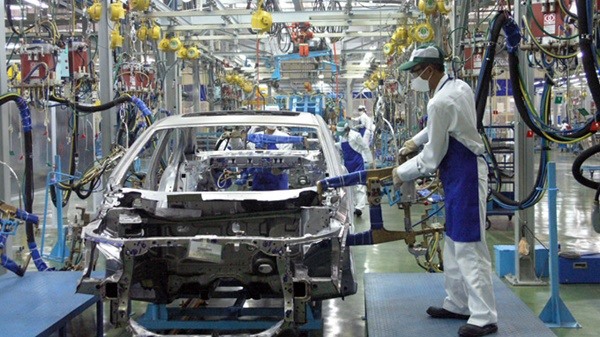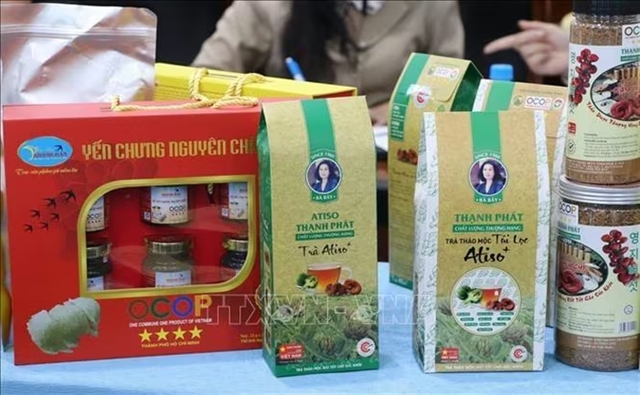 Economy
Economy

The country’s industrial sector posted high growth of 9.28 per cent in the first half of the year, surpassing the rates of 7.01 per cent and 5.42 per cent reached during the same periods in 2016 and 2017.
 |
| The country’s industrial sector posted high growth of 9.28 per cent in the first half of the year, surpassing the rates of 7.01 per cent and 5.42 per cent reached during the same periods in 2016 and 2017.— Photo aum.edu.vn |
HÀ NỘI — The country’s industrial sector posted high growth of 9.28 per cent in the first half of the year, surpassing the rates of 7.01 per cent and 5.42 per cent reached during the same periods in 2016 and 2017.
During a conference held in Hà Nội on Monday, the Ministry of Industry and Trade said the manufacturing and processing industry had posted growth of 13.02 per cent – the highest increase in the past seven years.
Dương Duy Hưng, director of the ministry’s Planning Department, said the Vietnamese economy had continued to enjoy growth in the second quarter of 2018 following impressive results in the first three months of this year
The index of industrial production (IIP) rose by 10.5 per cent from the corresponding period last year.”Notably, the main momentum for Việt Nam’s economic growth in the first half of the year came from improvements to the business environment, increased local consumption and the manufacturing and processing industry,” he added.
Some key industrial products saw high growth in the January-June period, including steel (up 43.7 per cent), woven fabrics of synthetic or manmade fibers (up 22.1 per cent), refined sugar (up 18.9 per cent) and liquified petroleum gas (up 18.5 per cent).
“The mineral sector saw favourable conditions as the prices of crude oil and some minerals were on the rise together with increasing consumption,” he said, adding that most companies in the sector had completed their targets for the first half of the year, creating momentum for the rest of 2018.
The relatively low economic growth rate during the first half of 2017 was also a factor contributing to a perception of this year’s high growth rate, he stated.
The Việt Nam Steel Association said the output of crude steel, rolled steel, steel bars and corner steel had increased by 43.7 per cent, 5.3 per cent and 16 per cent respectively. The sector expected high growth of 20 per cent this year.
The director said the growth was due to the stable local economy while many infrastructure, construction and real estate projects had been implemented in 2018. Minister Trần Tuấn Anh said the country should focus on improving the business environment to maintain high industrial growth.
The Government should also continue to simplify administrative procedures and enhance online public services.
“The industry and trade sector will also take measures to resolve delayed projects and loss-making firms. The ministry is working to resolve these shortcomings by the end of this year to create resources for the development of the industrial sector,” Anh said.
Việt Nam’s economy is now deeply integrated with the world, so it is naturally affected by changes to the global economy, according to Anh. The country’s economic growth has enjoyed the benefits of the global recovery in terms of trade and trade pacts.
However, Phan Văn Chinh, director of the Import-export Department, pointed out several challenges facing the country, such as policy changes from several of Việt Nam’s main importers, including the US, higher inflation pressure, and complicated weather conditions.
Minister Anh said that given the fact that trade conflicts were growing, with technical and trade production barriers rising, ministries and sectors should work together to tackle future problems. Although Việt Nam had signed a multiple free trade agreements and bilateral trade agreements, technical barriers and administrative procedures were still an issue, making it difficult to approach export markets, he said.
He stressed the need to study markets thoroughly in order to balance interests and spot weaknesses in cooperation mechanisms intended to facilitate the export of products. To achieve the targets set for 2018, the minister emphasised the need to improve the business and investment environment and speed up the restructuring of the industry and trade sector. Firms should also keep a close watch on market developments, Anh stated, pointing out that import-export activities were normally at their busiest in the second half of the year.
In addition, the Comprehensive and Progressive Agreement for Trans-Pacific Partnership and the EU-Việt Nam FTA, expected to become effective in 2018, had helped Việt Nam attract more foreign investors, helping to increase production capacity.
The ministry would intensify measures to remove barriers and create favourable conditions for exports, especially agricultural products and seafood, he added. — VNS




